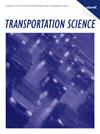A Day-to-Day Dynamical Approach to the Most Likely User Equilibrium Problem
IF 4.8
2区 工程技术
Q1 OPERATIONS RESEARCH & MANAGEMENT SCIENCE
引用次数: 0
Abstract
The lack of a unique user equilibrium (UE) route flow in traffic assignment has posed a significant challenge to many transportation applications. The maximum-entropy principle, which advocates for the consistent selection of the most likely solution, is often used to address the challenge. Built on a recently proposed day-to-day discrete-time dynamical model called cumulative logit (CumLog), this study provides a new behavioral underpinning for the maximum-entropy user equilibrium (MEUE) route flow. It has been proven that CumLog can reach a UE state without presuming that travelers are perfectly rational. Here, we further establish that CumLog always converges to the MEUE route flow if (i) travelers have no prior information about routes and thus, are forced to give all routes an equal initial choice probability or if (ii) all travelers gather information from the same source such that the general proportionality condition is satisfied. Thus, CumLog may be used as a practical solution algorithm for the MEUE problem. To put this idea into practice, we propose to eliminate the route enumeration requirement of the original CumLog model through an iterative route discovery scheme. We also examine the discrete-time versions of four popular continuous-time dynamical models and compare them with CumLog. The analysis shows that the replicator dynamic is the only one that has the potential to reach the MEUE solution with some regularity. The analytical results are confirmed through numerical experiments.History: This paper has been accepted for the Transportation Science Special Issue on ISTTT25 Conference.Funding: This research was funded by the United States National Science Foundation’s Division of Civil, Mechanical and Manufacturing Innovation [Grant 2225087]. The work of J. Xie was funded by the National Natural Science Foundation of China [Grant 72371205].Supplemental Material: The online appendix is available at https://doi.org/10.1287/trsc.2024.0525 .最可能用户平衡问题的日常动态方法
交通分配中缺乏唯一的用户均衡(UE)路线流,这给许多交通应用带来了巨大挑战。最大熵原则主张一致选择最可能的解决方案,经常被用来应对这一挑战。本研究基于最近提出的一种名为累积 logit(CumLog)的逐日离散时间动态模型,为最大熵用户均衡(MEUE)路线流提供了一种新的行为基础。事实证明,CumLog 可以在不假定旅行者完全理性的情况下达到 UE 状态。在此,我们进一步证实,如果(i) 旅行者没有关于路线的先验信息,因此被迫给予所有路线相等的初始选择概率,或者(ii) 所有旅行者从同一来源收集信息,从而满足一般比例条件,那么 CumLog 总能收敛到 MEUE 路线流。因此,CumLog 可以作为 MEUE 问题的实用求解算法。为了将这一想法付诸实践,我们建议通过迭代路线发现方案来消除原始 CumLog 模型中的路线枚举要求。我们还研究了四种流行的连续时间动力学模型的离散时间版本,并将它们与 CumLog 进行了比较。分析表明,复制器动态模型是唯一一种有可能达到 MEUE 解的模型,而且具有一定的规律性。分析结果通过数值实验得到了证实:本文已被 ISTTT25 会议交通科学专刊接受:本研究由美国国家科学基金会土木、机械和制造创新部[2225087 号基金]资助。J. Xie 的工作得到了国家自然科学基金[72371205]的资助:在线附录见 https://doi.org/10.1287/trsc.2024.0525 。
本文章由计算机程序翻译,如有差异,请以英文原文为准。
求助全文
约1分钟内获得全文
求助全文
来源期刊

Transportation Science
工程技术-运筹学与管理科学
CiteScore
8.30
自引率
10.90%
发文量
111
审稿时长
12 months
期刊介绍:
Transportation Science, published quarterly by INFORMS, is the flagship journal of the Transportation Science and Logistics Society of INFORMS. As the foremost scientific journal in the cross-disciplinary operational research field of transportation analysis, Transportation Science publishes high-quality original contributions and surveys on phenomena associated with all modes of transportation, present and prospective, including mainly all levels of planning, design, economic, operational, and social aspects. Transportation Science focuses primarily on fundamental theories, coupled with observational and experimental studies of transportation and logistics phenomena and processes, mathematical models, advanced methodologies and novel applications in transportation and logistics systems analysis, planning and design. The journal covers a broad range of topics that include vehicular and human traffic flow theories, models and their application to traffic operations and management, strategic, tactical, and operational planning of transportation and logistics systems; performance analysis methods and system design and optimization; theories and analysis methods for network and spatial activity interaction, equilibrium and dynamics; economics of transportation system supply and evaluation; methodologies for analysis of transportation user behavior and the demand for transportation and logistics services.
Transportation Science is international in scope, with editors from nations around the globe. The editorial board reflects the diverse interdisciplinary interests of the transportation science and logistics community, with members that hold primary affiliations in engineering (civil, industrial, and aeronautical), physics, economics, applied mathematics, and business.
 求助内容:
求助内容: 应助结果提醒方式:
应助结果提醒方式:


